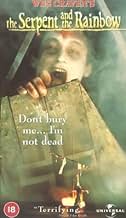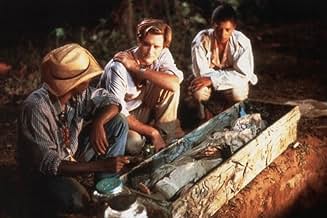PUNTUACIÓN EN IMDb
6,4/10
28 mil
TU PUNTUACIÓN
Un antropólogo viaja a Haití después de escuchar rumores sobre una droga que usan los practicantes de magia negra para convertir a las personas en zombis.Un antropólogo viaja a Haití después de escuchar rumores sobre una droga que usan los practicantes de magia negra para convertir a las personas en zombis.Un antropólogo viaja a Haití después de escuchar rumores sobre una droga que usan los practicantes de magia negra para convertir a las personas en zombis.
- Premios
- 1 nominación en total
Jaime Pina
- Julio
- (as Jaime Piña Gautier)
Kimberleigh Aarn
- Margrite
- (as Kimberleigh Burroughs)
Argumento
¿Sabías que...?
- CuriosidadesDue to political strife and civil turmoil in Haiti during the production, the local government informed the film crew that they could not guarantee their safety for the remainder of the shoot. The crew subsequently relocated to nearby Dominican Republic to complete filming.
- PifiasAt about the 1:05 mark a computer screen shows the word "specimen" misspelled as "speciman".
- Citas
Dennis Alan: Don't let them bury me! I'm not dead!
- Créditos adicionales[Opening card] In the legends of voodoo the Serpent is a symbol of Earth. The Rainbow is a symbol of Heaven. Between the two, all creatures must live and die. But because he has a soul Man can be trapped in a terrible place Where death is only the beginning. The following is inspired by a true story.
- Versiones alternativasUK video and DVD versions are cut by 5 seconds by the BBFC to remove shots of cock-fighting (illegal animal cruelty).
- Banda sonoraMadame Marcel
Performed by Le Roi Coupe Cloue
Courtesy of Chancy Records
Reseña destacada
A researcher (Bill Pullman) goes to Haiti in order to find a "zombie drug" that can give someone the appearance of death, when in actuality their body is at its lowest functioning. They may not breathe, or bleed, but they are not truly dead. The researcher and the company he works for hope to use it as an anesthetic.
The film started as a book of the same name by anthropologist Wade Davis, who is probably the world's authority on voodoo and zombies. Discussions were made to have Peter Weir direct and/or Mel Gibson star, but obviously this never happened. The script found its way to Wes Craven, and Bill Pullman (at that point a young rising star) was given the lead.
Author Wade Davis was on set from the very beginning and wanted to make the best film he could regardless of who the director would be. He notoriously did not like the way it went, and Bill Pullman says that both he (Pullman) and Wes Craven were disappointed, too, because they wanted a more serious angle and the studio (Universal) was pushing for a horror story. In retrospect, Davis seems to have become more accepting of the film and does not hold it against Craven. In fact, he praises many of the scenes for their authenticity, especially in comparison to other attempts at making voodoo films.
The filming took place throughout 1987, and the political tensions were getting nasty in Haiti. Dictator Jean-Claude "Baby Doc" Duvalier becomes part of the plot, which makes this not just an anthropological horror film, but a political one, too. If people are able to look past the horror aspects, there is actually an important cultural document here.
While the film is quite interesting for a variety of reasons, it starts off slow, and does not really pick up until the second half. Bill Pullman's character is the only one you are going to get to know from this film, and the only character who gets a lot of development. The natives seem very flat, and most just come across as wanting to kill Pullman. In a way, this makes sense, because this story is essentially told from his point of view.
Bill Pullman reflected years later, "I don't think any other movie I've done is as adventurous as this one." He did most of his own stunts, met with real voodoo priests and took part in a variety of activities that may not be your typical Hollywood situation. One scene was filmed in an actual Dominican grave. He confirms that writer Richard Maxwell had to be admitted to an asylum after consulting with a voodoo priest.
Fans of Craven ought to check this one out. It does not have the in-your-face slasher horror of Craven's "Nightmare on Elm Street", "Scream" or "Last House on the Left". But it is not intended to be. This is a film built on atmosphere, and in many ways a horror more realistic than any he had ever done before.
As always, the must-have version was released by the fine folks at Scream Factory. Those interested in the movie will have to watch the 25-minute "making of", which has interviews with cinematographer John Lindley, the father-son special effects team of Lance and Dave Anderson, Wade Davis, and some re-used audio from Pullman.
The audio commentary is disappointing. On the one hand, it is the first time the film has had a commentary track, so credit must be given to Scream Factory for giving the disc the attention that past companies (specifically Image and Universal) failed to do. But the commentary with Bill Pullman only goes halfway through the film, with no one left to take his place. The real tragedy is in the passing of Wes Craven (the disc is dedicated to him), who could have offered more insight.
There will undoubtedly never be a better release of this essential Wes Craven film... unless someone manages to convince Bill Pullman to hand over all the vacation footage he shot with his wife on set!
The film started as a book of the same name by anthropologist Wade Davis, who is probably the world's authority on voodoo and zombies. Discussions were made to have Peter Weir direct and/or Mel Gibson star, but obviously this never happened. The script found its way to Wes Craven, and Bill Pullman (at that point a young rising star) was given the lead.
Author Wade Davis was on set from the very beginning and wanted to make the best film he could regardless of who the director would be. He notoriously did not like the way it went, and Bill Pullman says that both he (Pullman) and Wes Craven were disappointed, too, because they wanted a more serious angle and the studio (Universal) was pushing for a horror story. In retrospect, Davis seems to have become more accepting of the film and does not hold it against Craven. In fact, he praises many of the scenes for their authenticity, especially in comparison to other attempts at making voodoo films.
The filming took place throughout 1987, and the political tensions were getting nasty in Haiti. Dictator Jean-Claude "Baby Doc" Duvalier becomes part of the plot, which makes this not just an anthropological horror film, but a political one, too. If people are able to look past the horror aspects, there is actually an important cultural document here.
While the film is quite interesting for a variety of reasons, it starts off slow, and does not really pick up until the second half. Bill Pullman's character is the only one you are going to get to know from this film, and the only character who gets a lot of development. The natives seem very flat, and most just come across as wanting to kill Pullman. In a way, this makes sense, because this story is essentially told from his point of view.
Bill Pullman reflected years later, "I don't think any other movie I've done is as adventurous as this one." He did most of his own stunts, met with real voodoo priests and took part in a variety of activities that may not be your typical Hollywood situation. One scene was filmed in an actual Dominican grave. He confirms that writer Richard Maxwell had to be admitted to an asylum after consulting with a voodoo priest.
Fans of Craven ought to check this one out. It does not have the in-your-face slasher horror of Craven's "Nightmare on Elm Street", "Scream" or "Last House on the Left". But it is not intended to be. This is a film built on atmosphere, and in many ways a horror more realistic than any he had ever done before.
As always, the must-have version was released by the fine folks at Scream Factory. Those interested in the movie will have to watch the 25-minute "making of", which has interviews with cinematographer John Lindley, the father-son special effects team of Lance and Dave Anderson, Wade Davis, and some re-used audio from Pullman.
The audio commentary is disappointing. On the one hand, it is the first time the film has had a commentary track, so credit must be given to Scream Factory for giving the disc the attention that past companies (specifically Image and Universal) failed to do. But the commentary with Bill Pullman only goes halfway through the film, with no one left to take his place. The real tragedy is in the passing of Wes Craven (the disc is dedicated to him), who could have offered more insight.
There will undoubtedly never be a better release of this essential Wes Craven film... unless someone manages to convince Bill Pullman to hand over all the vacation footage he shot with his wife on set!
- gavin6942
- 7 feb 2010
- Enlace permanente
Selecciones populares
Inicia sesión para calificar y añadir a tu lista para recibir recomendaciones personalizadas
Detalles
Taquilla
- Presupuesto
- 7.000.000 US$ (estimación)
- Recaudación en Estados Unidos y Canadá
- 19.595.031 US$
- Fin de semana de estreno en EE. UU. y Canadá
- 5.848.700 US$
- 7 feb 1988
- Recaudación en todo el mundo
- 19.595.031 US$
- Duración1 hora 38 minutos
- Color
- Mezcla de sonido
- Relación de aspecto
- 1.85 : 1
Contribuir a esta página
Sugerir un cambio o añadir el contenido que falta

Principal laguna de datos
What is the Italian language plot outline for La serpiente y el arco iris (1988)?
Responde




































